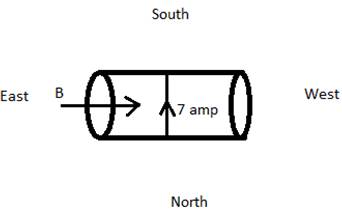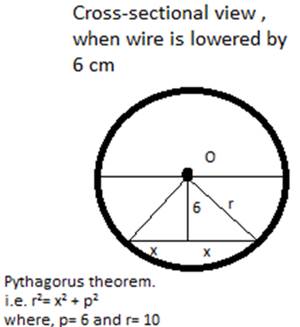A uniform magnetic field of 1.5 T exists in a cylindrical region of radius 10.0 cm, its direction parallel to the axis along east to west. A wire carrying current of 7.0 A in the north to south direction passes through this region. What is the magnitude and direction of the force on the wire if,
(a) the wire intersects the axis,
(b) the wire is turned from N-S to northeast-northwest direction,
(c) the wire in the N-S direction is lowered from the axis by a distance of 6.0 cm?
Given:
Magnetic field strength, B = 1.5 T
Radius of cylinder, r = 10 cm
Current in wire travelling north to south, I = 7A

(a) Let the force on wire = F1
If the wire intersects the axis of the magnetic field, then we observe that length of wire will be equal to the diameter of the cylinder.
L1 = 2 × r = 20 cm
We know that,
F = B × I × L1 × sinθ …(1)
Where,
F = Force on wire
B = magnetic field strength
I = current through the wire
L1 = length of wire
θ = angle between direction of field and direction of current
Since, the field is along east to west and current flows along north south, direction so, θ = 90°.
By putting the values of B, I and L1 in equation 1.
⇒ F = 1.5T × 7A × 0.2m × sin90°
⇒ F = 2.1 N
So, force on wire is 2.1 N and it acts in vertically downward direction.
(b) Let the force on wire = F2
If the wire is turned towards Northeast-Northwest direction.
We observe that wire has been turned 45°, i.e. θ = 45°
L2 = L1/sinθ.
L2 = 2 × L1
F2 = B × I × L2 × sinθ
F2 = B × I × L2
F2 = 2.1 N
Hence the force is 2.1 N and it acts vertically downwards.

(c) Let, the force on wire = F3
The wire has been lowered 6 cm,
⇒ x = ( r2-p2)0.5
⇒ x = ( 100-36)0.5
⇒ x = 8
So length of wire in the magnetic field region = 16 cm
(By using the geometry)
We know that,
F = B × I × L1 × sinθ …(1)
Now, putting the values in B, T and I in equation 1.
⇒ F = 7T × 0.16A × 1.5T
⇒ F = 1.68 N
The direction of the force will be vertically downward, the direction of force is given by screw rule.